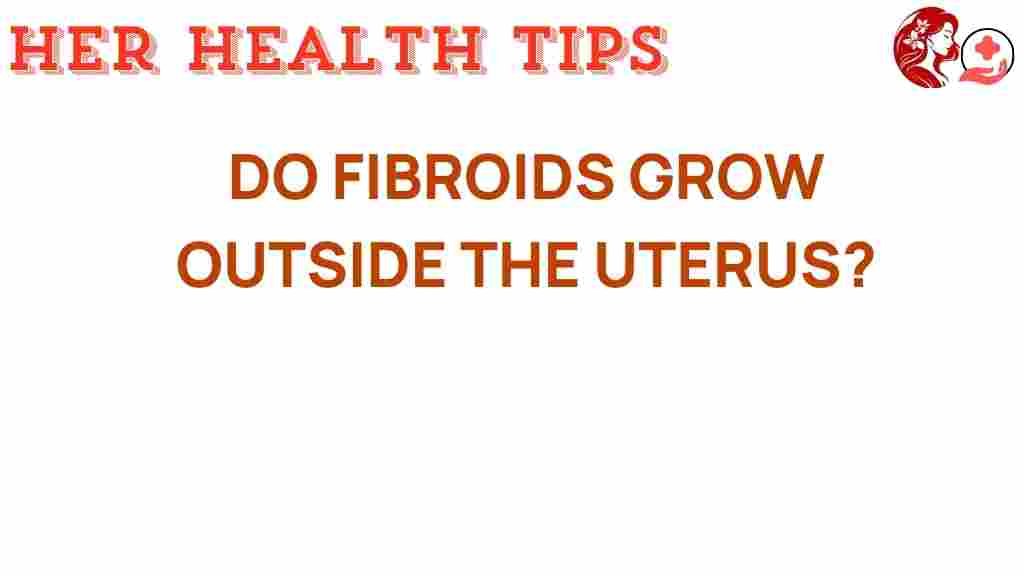Unraveling the Mystery: Do Fibroids Grow Outside the Uterus?
Fibroids are non-cancerous growths that can develop in or on the uterus. For many women, these growths are a common part of reproductive health, yet they can lead to various symptoms and complications. Understanding the nature of fibroids, their growth patterns, and potential treatments is essential for women who may be affected by them. In this article, we will explore whether fibroids can grow outside the uterus, their symptoms, diagnosis, and treatment options, and provide valuable insights into maintaining reproductive health.
What Are Fibroids?
Fibroids, also known as uterine leiomyomas or myomas, are benign tumors made of muscle and fibrous tissue. They can vary in size, from small seedlings to large masses that can distort the shape of the uterus. While the exact cause of fibroids is not fully understood, they are influenced by hormonal changes, particularly estrogen and progesterone, and are most common in women of reproductive age.
Do Fibroids Grow Outside the Uterus?
The primary location for fibroid growth is within the uterus, but they can also develop outside the uterus in rare cases. Here’s a look at how fibroids can manifest:
- Intramural Fibroids: These are located within the muscular wall of the uterus.
- Submucosal Fibroids: These grow just beneath the uterine lining and can protrude into the uterine cavity.
- Subserosal Fibroids: These are found on the outer surface of the uterus and can extend outward.
- Pedunculated Fibroids: These are attached to the uterus by a stalk and can hang outside the uterine wall.
While fibroids primarily grow within the uterus, subserosal fibroids can be mistaken for growths outside the uterus due to their positioning. It’s essential to consult a healthcare professional to determine the exact nature and location of fibroids.
Symptoms of Fibroids
Many women with fibroids may not experience symptoms, but when symptoms do occur, they can significantly impact health and quality of life. Common symptoms include:
- Heavy menstrual bleeding or prolonged periods
- Pelvic pain or pressure
- Frequent urination
- Difficulties emptying the bladder
- Constipation
- Back or leg pain
- Enlarged abdomen
If you experience any of these symptoms, it’s crucial to seek medical advice for proper diagnosis and management.
Diagnosis of Fibroids
Diagnosing fibroids typically involves a combination of medical history, physical examination, and imaging tests. Here are the common steps in the diagnosis process:
- Medical History: Your doctor will ask about your symptoms and menstrual history.
- Physical Examination: A pelvic exam may be conducted to feel for abnormalities.
- Imaging Tests: Ultrasound is the most common method, but MRI or CT scans can also be used for detailed imaging.
- Other Diagnostic Tools: In some cases, a hysteroscopy or laparoscopy might be performed to visualize fibroids directly.
Early diagnosis is essential to manage symptoms effectively and maintain reproductive health.
Treatment Options for Fibroids
Treatment for fibroids depends on several factors, including the size and location of the fibroids, the severity of symptoms, and the woman’s desire for future pregnancies. Treatment options include:
- Watchful Waiting: If fibroids are asymptomatic, doctors may recommend monitoring them over time.
- Medications: Hormonal therapies such as birth control pills or GnRH agonists can help manage symptoms by regulating hormone levels.
- Non-Invasive Procedures: MRI-guided focused ultrasound surgery (FUS) can destroy fibroids without incisions.
- Minimally Invasive Procedures: Uterine artery embolization (UAE) blocks blood flow to the fibroids, causing them to shrink.
- Surgical Options: Hysterectomy (removal of the uterus) is a definitive solution, while myomectomy (removal of fibroids) preserves the uterus for women who wish to conceive.
It’s important to discuss all available treatment options with your healthcare provider to determine the best approach for your situation.
Maintaining Reproductive Health with Fibroids
Women diagnosed with fibroids should consider lifestyle choices and regular check-ups as part of their health strategy:
- Regular Check-Ups: Regular gynecological exams can help monitor fibroids and any changes in symptoms.
- Healthy Diet: A balanced diet rich in fruits, vegetables, and whole grains can support overall health and potentially help manage symptoms.
- Exercise: Regular physical activity can help maintain a healthy weight and reduce the risk of complications.
- Stress Management: Techniques such as yoga, meditation, and deep breathing can help alleviate stress, which may exacerbate symptoms.
For more information on maintaining reproductive health, you can visit this resource.
Troubleshooting Common Concerns
Women experiencing symptoms related to fibroids may have several concerns. Here are some common questions and troubleshooting tips:
- Can fibroids turn into cancer? Fibroids are benign and do not turn into cancer. However, it’s essential to monitor any changes in symptoms.
- Are fibroids hereditary? There is a genetic component, so a family history of fibroids can increase the likelihood of developing them.
- Can fibroids affect pregnancy? Fibroids can sometimes interfere with pregnancy, but many women with fibroids have successful pregnancies.
- How can I alleviate pain caused by fibroids? Over-the-counter pain relievers, heat therapy, and relaxation techniques may help manage pain.
If you have specific concerns about your symptoms or treatment options, always consult your healthcare provider for personalized advice.
Conclusion
Understanding fibroids and their growth patterns is essential for women’s health. While fibroids primarily grow within the uterus, they can also develop in ways that may seem to extend beyond it. Recognizing symptoms, seeking timely diagnosis, and exploring treatment options are crucial steps in managing fibroids effectively. By maintaining regular check-ups and adopting a healthy lifestyle, women can take proactive measures towards their reproductive health. If you suspect you have fibroids or are struggling with symptoms, don’t hesitate to reach out to a healthcare professional for guidance and support.
For further reading on fibroids and women’s health, check out this article.
This article is in the category Reproductive and created by HerHealthTips Team
